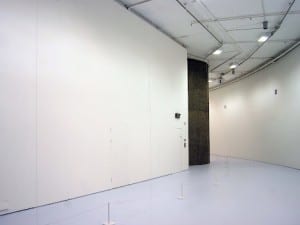The Wapping Project’s smaller Bankside residence presents ten large-scale photographic prints from Dutch artist Jacqueline Hassink. View, Kyoto is the product of a 10-year exploration of Japanese gardens, and a visual study of the contrast between indoor and outdoor space, the juxtaposition of imperfect natural forms with sharp dynamic architecture – all set against a dramatic background of the changing of the seasons.
The exhibition itself is slightly underwhelming, however this is due to curation rather than any reflection upon Hassink’s skill. The Wapping Project’s Bankside space features two lengthy glass walls, so the space is almost open to the street, however Hassink’s photographs demand isolation to fully envelop the viewer into their unique calm.
The saving grace of this exhibition is its accompanying multi-channel film. Here Hassink’s stills are vast projections which light up a small dark space, and with no other visual distractions the viewer is immediately transported: here temple mats glow blood-red against bright white flakes of snow, which appear so crisp that their icy cold is near tangible.
Hassink’s film piece also includes footage of several Buddhist monks, they explain the significance of the Japanese garden as not a place to be viewed, but an “object of worship” and in light of this, it seems bizarre that an artist would indeed present them as stills to be viewed. However, after listening to various characters speak of their gardens with such adoration, the impact of Hassink’s photographs is significantly altered. The monks speak in distain of temples which employ gardeners to tend the land, which is understandable as there is something so utterly serene in watching a lone monk with a rake reworking the sand of the Zen garden, whist another explains that “if there is sadness in one’s mind, the pattern may look sad; or if one has a confused mind, the lines will come out crooked”.
For twenty minutes, this film installation removes the viewer from the streets of Bankside and repositions them within a sphere of tranquillity, where the sole focus is one’s own thoughts and peace of mind – far removed from the fast pace of city life. To leave this small room for the glass-walled gallery is to reconnect to contemporary London with a jolt.
Shaden-ji- Summer is the print which most resonates with Hassink’s film; it depicts a lone white orchid in a slender glass vase atop a glossy table. Outside, tall pine trees point to the sky and perfectly cropped topiary bushes echo the rounded forms of the smooth mahogany table. The photograph is silent and solitary, its absolute calm juxtaposing with the central setting of The Wapping Project.
The first UK exhibition of Jacqueline Hassink’s View, Kyoto presents views of an idealistic lifestyle, in a less than ideal setting, whilst highlighting the great value of the Buddhist idea of having “a space in which to settle one’s mind.”
Chloe Hodge
Jacqueline Hassink: View, Kyoto, 13 September until 20 October, The Wapping Project, 65a Hopton Street, London, SE1 9LR. www.thewappingprojectbankside.com
Credits:
1. Hosen-in, 2004. Courtesy the artist and The Wapping Project.
2. Shoden-ji summer North West Kyoto 22 July 2004, 2004. Courtesy the artist and The Wapping Project.





